|
|
|
TAIL FLASH HISTORY OF THE 318TH FIS |
|
|
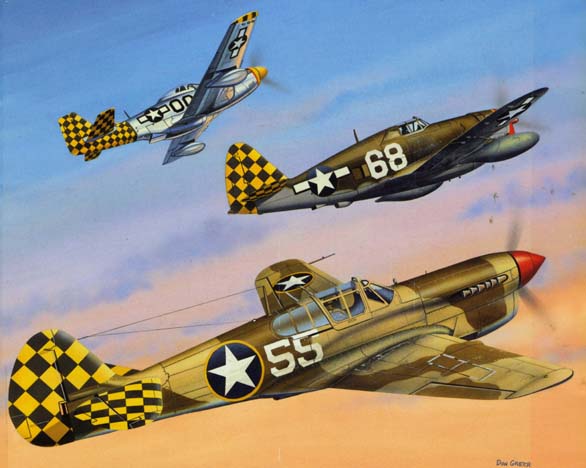 |
|
x |
|
Setting The iconic "Checkertail" can be seen in this painting
by aviation artist Don Greer depicting
aircraft flown by the 318th Fighter Squadron and its sister squadrons of
the 325th Fighter Group during World War II.
|
|
|
|
Throughout military
history, warriors have carried their unit colors into battle, raising
them high to make an impression on their enemies. Not only have those
symbols stood to represent a unit, they have served as markings that
give each unit member a sense of belonging and pride.
|
|
|
|
In the initial
deployments of U.S. Army Air Force to the European and African theaters
in 1942 involved relatively small numbers of fighter and bomber aircraft
and no system of Group identification was used. Some aircraft were
identified by numbers painted on their fuselage. The fighters of the
325th Fighter Group were no different, adding a large US flag to their
P-40 painted in standard camouflage and markings.
|
|
|
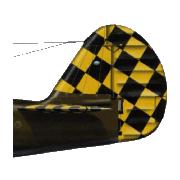 |
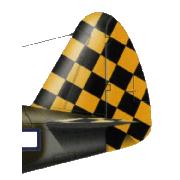 |
|
P-40 Warhawk |
P-47 Thunderbolt |
|
|
|
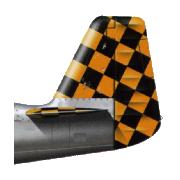 |
|
P-51 Mustang |
|
|
|
In mid 1943, the
Northwest African Air Force (NAAF) issued a request to all of its
fighter and bomber groups to design and apply unit specific
identification markings for their aircraft. This request by the NAAF was
to provide crews with a quick means of identifying a particular bomber
or fighter group during missions. Using the Checkerboard design of WWI
German ace Lt. Werner Voss as inspiration John Watkins of the 318th FS
and Maj. Bob Baseler of the 317th FS set out to create a similar design
for the aircraft of the 325th.
|
|
|
|
Concentrating on the
tails of the 325th Fighter Groups P-40s, different sizes and colors were
tested, at the end the yellow and black "Checkertail" design was born.
The Checker Tail would be used on all of the Groups aircraft (including
Group B-26 & B-25 "Hacks" or utility aircraft) with 12" squares on
P-47s, and 10" squares on P-51.
|
|
|
%20HAMILTON%201948%20img-1169%20550X301.jpg) |
|
PHOTO FROM
"NORTHROP'S
NIGHT HUNTER P-61 BLACK WIDOW" BY ALVIN E."BUD" ANDERSON |
|
Other than a
aircraft number and a yellow spinner cap in their propellers, P-61Bs of
the 318th Fighter Squadron (All Weather) wore standard markings as seen
on P-61B s/n 48-8279 at Hamilton Field in 1948.
|
|
|
|
Upon reactivation, the
318th was issued the Northrop P-61 Black Widows, other that occasional
nose art and radio call numbers, the tails of the squadrons P-61s wore
no unit specific markings. In 1948, the 318th moved into the North
American F-82 Twin Mustang and moved to add some identity to their
aircraft by adding the "Green Dragon" insignia on the outer surface of
both tails of the twin-tailed fighter, some aircraft would also carry
individual "nose art" on the radar pods of the F-82's.
|
|
|
|
There was little change
for the tails on the next aircraft flown by the 318th and the 325th
Fighter Group, the Lockheed F-94A Starfire; a Group shield replaced the
Green Dragon insignia. The squadron insignia would move from the tail to
both sides of the fuselage below the canopy. The only splash of color
was a horizontal tail stripe denoting an airplanes assignment, yellow
was the color reserved for the 318th, (red for the 317th and blue for
the 319th). Later the Greenland bound F-94's completely painted their
tails of their new F-94B's with bright red arctic markings. The use of
these markings was intended to assist rescue crews in the search and
rescue of crews and aircraft in snowy areas. A broad red stripe bordered
in black would also be added to Green Dragon F-94Bs.
|
|
|
|
In 1954, the Green
Dragons replaced their worn F-94's with new Northrop F-89 Scorpion, and
kept the basic Arctic markings designed for F-89's assigned to northern
units. Some aircraft would carry yellow wing tanks with red scallop.
|
|
|
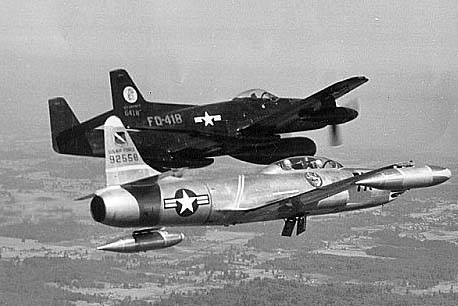 |
|
|
|
The 318th insignia can be seen on the tail of this F-82 Twin Mustang
, while the 325th Fighter Group insignia is displayed on the F-94
Starfire. Note the two fuselage stripes on the F-94 denoting that the
aircraft is assigned to the squadrons "DO" or Director of Operations (Ops
Officer)
|
|
|
|
After the 318th FIS
designator replaced the 465th FIS at McChord, the unit used that
opportunity to change the tail flash of their F-86s. Using the main
color from the 465th markings, the 318th created a new look for their
Sabres keeping the yellow background (thought to be F.S. 13538) but
replacing the 456ths three red lightning bolts with two black chevrons (F.S.
17038) on a
enlarged yellow tail (thought to be F.S. 13538), with black trim on the lower section. A single black
chevron would also be added to the wing tanks.
|
|
|
 |
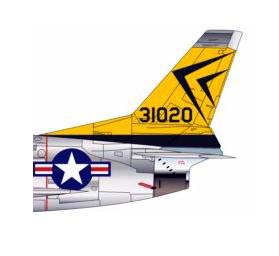 |
|
456th FIS F-86 tail flash |
318th FIS F-86 tail flash |
|
|
|
With the anticipation
running very high for the squadron supersonic replacement for the F-86,
the 318th began looking for a new tail design that would complement the
speed and their futuristic Convair F-102's. In early 1957, the 318th
held a contest to find a new tail emblem for the yet to arrive F-102's,
artwork from a member of the 318th, TSgt Bruce McElhaney, would be
proclaimed as the winner. The design, called "Mach Wave" used elements
of Chryslers "Forward Look" emblem, the signature of a campaign
concerning radical redesign of the company's vehicles for the 1955 model
year.
|
|
|
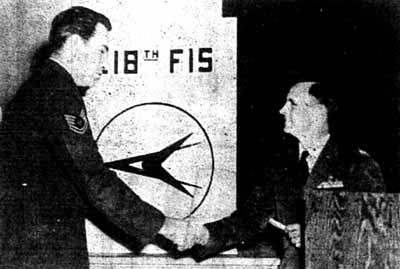 |
|
x |
|
Taken from the Bases newspaper (The Defender") the winner of the
F-102 tail flash design contest TSgt Bruce McElhaney is
congratulated by 318th Executive Officer Maj William A Clair. The
caption reads " The 318th FIS has its first F-102A interceptors and they
have re-designed and streamlined their "Mach Wave" emblem to b painted
on the F-102 tails. The above photo shows Maj William A. Clair,
executive officer of the 318th, presenting a check to TSgt. Bruce G
McElhaney for submitting the winning design. The "Mach Wave" design is
black on a field of yellow rimmed by a black circle and is patterned
after the "Forward Look" emblem, of the Chrysler Corporation. The pilots
and ground crew of the 318th feel that their new F-102's typify the
"Forward Look" in air power and this design is ideally suited to their
forthcoming operation in supersonic flight.
|
|
|
|
The Forward Look logo
consisted of two overlapped chevrons, suggesting space age theme. The
black (F.S. 17038) and yellow (F.S. 13538) colors of the 318th Mach Wave were the same used with
the 318th F-86 tail design. The "Mach Wave" was used to personalize many
items belonging to the 318th and later to the 325th Fighter Wing
including flight helmets, the back of flight jackets, unit ball caps and
even some of the Wings aerospace equipment. Even the T-33's got in the
act, with large Mach Waves over their day-glo red tails.
|
|
|
 |
|
|
|
The Mach Wave design
was first used exclusively by the 318th FIS at McChord. The other
squadron at McChord, the 317th, used their F-86 design (a white
lightning bolt on a broad red stripe) on their Deuces. After the 317th
moved north to Alaska, 64th FIS moved down to join the 318th, from there
forward, the Mack Wave was used by both squadrons as the official 325th
FW design. Squadron insignias on the nose of the F-102 would be used to
denote squadron "ownership", for a period of time; fights were denoted
by various colors painted on speed brake doors.
|
|
|
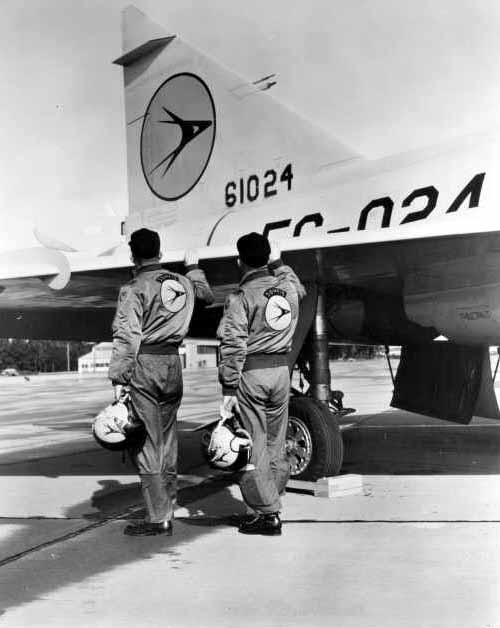 |
|
|
|
Two pilots of the 318th FIS hold their customized helmets while
admiring the units new tail flash in their "Mach Wave" flight jackets.
|
|
|
|
In early 1960, the
tails seen on the flightline at McChord were no longer those of the
F-102, they were now the "Deuces" more advanced cousin, the F-106 Delta
Dart. This upgrade to the Ultimate Interceptor required a new design to
match the squadrons new capability - enter the "North Star" or
"Compass
Rose" design devised by 318th pilot 1st Lt. Gary K. Carroll who in 1971
as a Major would win a Distinguished Flying Cross while flying a forward
air control mission over Southeast Asia.
|
|
|
|
The new design, eight light
blue (F.S. 15200) & dark blue (F.S. 15044) contrasting legs radiating from a disc that contained
the Air Defense Command shield (on the right hand side) and the 318th
FIS insignia (on the left hand side). In the early years of this era,
the squadron painted the F-106's entire speed brake doors in a different
color to represent each flight, there is some evidence that a few
aircraft wore the Green Dragon insignia on both sides of the tail for a
very short period.
|
|
|
|
After the addition of another F-106
squadron in July of 1963 (the 498th FIS from Geiger Field, WA), the
318th insignia was replaced by the 325th Fighter Wing Shield. This was
the norm for the Wing's markings until the relocation of the 498th in
June of 1966.
|
|
|
 |
|
x |
|
F-106 pilot 1Lt. Gary K. Carroll talks about the F-106 and the
squadrons new tail design with TSgt. William F. Ramsay, Crew Chief of
F-106 s/n 59-0055, a design created by Lt. Carroll.
|
|
|
|
Towards the end of the
60's, another change was in the works for the 318ths tail flash. The
colors remained the same, but the design would be reworked in to "chevron"
with three legs extending from the rear. Again, the scheme would be
designed around a disc with the Air Defense Command shield on the right
hand side and the 318th FIS insignia on the left hand side.
|
|
|
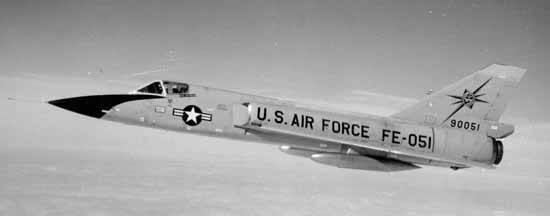 |
|
x |
|
One of the first
F-106s assigned to the 318th FIS, s/n 59-0051
is pictured above with the units "Green Dragon" insignia within the "Compass
Rose" tail flash in July 1963. In the lower picture
F-106A s/n 59-0058 displays the 325th Fighter Wing insignia in the
center of the "Compass Rose" tail flash, the 325th FW insignia was worn
after the 498th FIS arrived to McChord From Geiger AFB, WA. It is
thought that the 318th insignia on the nose of the aircraft was only
worn by aircraft participating in the William Tell Competition.
|
|
|
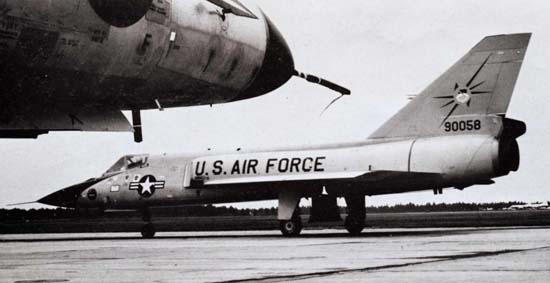 |
|
PHOTO FROM THE MARTY ISHAM COLLECTION |
|
|
|
Around the
same time, the 318th became the first F-106 squadron to receive the
streamline 360gal supersonic wing tanks replacing the 230gal tanks. For
the first time in the F-106, the wing tanks would be customized, a broad
light blue / dark blue stripe with a white "318 FIS" superimposed in the
center of the tank. Later, both sets of the markings would be outlined
in white.
|
|
|
|
|
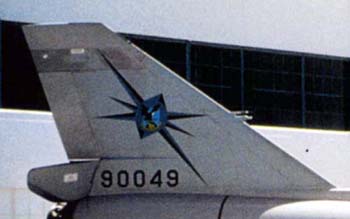 |
|
x |
|
The first 318th FIS
/325th FW tail flash (L) was worn by McChord F-106s from 1960 until the
1966 - 1967 time frame, it was replaced by the design on the right. The
Air Defense Command insignia was displayed on the right side of the
tail, the 318th FIS or the 325th FW insignia could be found on the left
side.
|
|
|
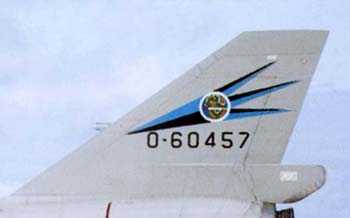 |
|
|
 |
|
x |
|
The markings of
T-33's flying in ADC squadrons mimic those of their big brothers, as
seen by T-33A s/n 58-0512 wearing markings similar to those of the units
F-106's. In the picture below the left side of the T-33 is shown on
T-33A s/n 57-0566, note the "full sized" ADC shield used on all 318th
T-33s with the "Chevron" markings.
|
|
|
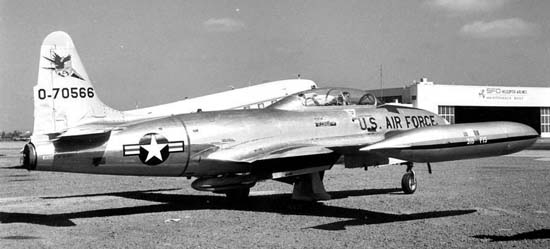 |
|
|
|
In late 1974, early
1975 an ADC wide order was in place that called for the reduction in
markings of all aircraft in the command. For a period of time, some
aircraft would only display the Aerospace Defense Command shield on the
right hand side of the tail and the 318th FIS insignia on the left hand
side of the tail. In William Tell 1974, a slight change to the 318ths
wing tank markings was noticed, the colors would be switched, (dark blue
on top, light blue on the bottom), and a white scallop would extend over
the nose cone.
|
|
|
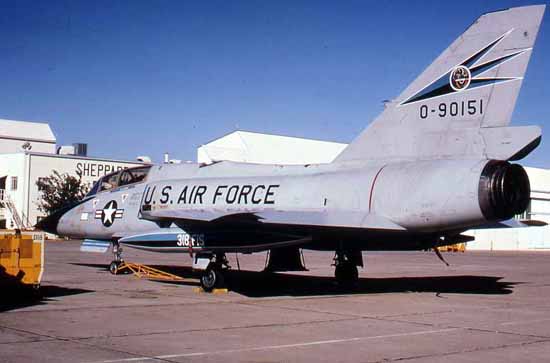 |
|
|
|
After adding a white
outline to the tail and tank markings in the late 60s - early 70s (above),
the squadron suffered through a period where unit markings were not
displayed. After their return the squadron markings on the tanks were
slightly revised (below).
|
|
x |
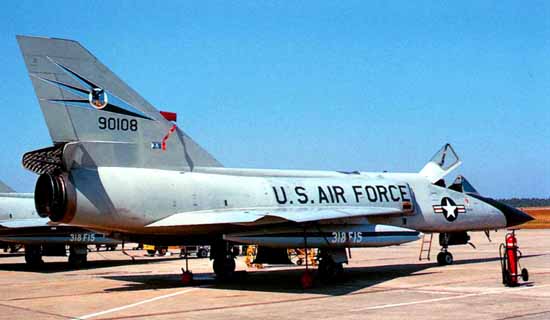 |
|
|
|
In 1975 / 1976, time
sought out to freshen up the units tail flash, and they really did! The
new markings for the units F-106's & T-33's, similar to a "Starburst",
was in many respects a larger version of the early 60's F-106 tail
flash, except larger with the eight legs radiating from the center disc,
out to the edges of the tail. The lower leg would break through the
airplanes serial number (on the F-106's). No tank markings were designed
- at first.
|
|
|
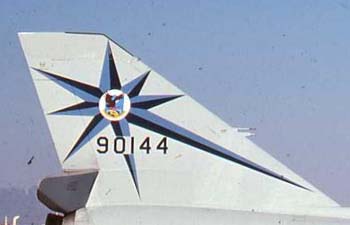 |
|
x |
|
Unlike the "Compass
rose" design, the standard location was kept for the tail number with
the "Starburst" design. To keep the numbers visible, a 1 inch
boarder was around each number that broke through the design. The
Aerospace Defense Command (L) and the 318th FIS insignia (R) can be seen
high in the center of the "Starburst".
|
|
|
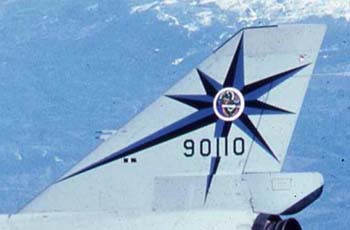 |
|
|
|
In 1975 / 1976, time
sought out to freshen up the units tail flash, and they really did! The
new markings for the units F-106's & T-33's, similar to a "Starburst",
was in many respects a larger version of the early 60's F-106 tail
flash, except larger with the eight legs radiating from the center disc, out to the edges of the tail. The lower leg would break through the
airplanes serial number (on the F-106's). No tank markings were designed
- at first.
|
|
|
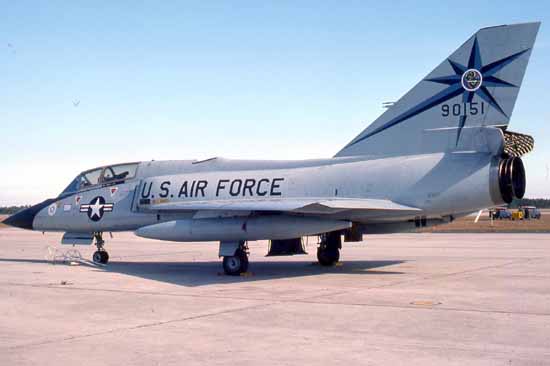 |
|
x |
|
A few years later
F-106B s/n 59-0151 was repainted with the new "Starburst" design. The
F-106 is pictured at Tyndall AFB, FL during William Tell '76. As
the F-106s tails were repainted , 318th T-33s tails were repainted with
the same design as seen on T-33 s/n 58-0578 in the late 70's. T-33 -578
was believed to be the first gray T-Bird serving with the 318th.
|
|
|
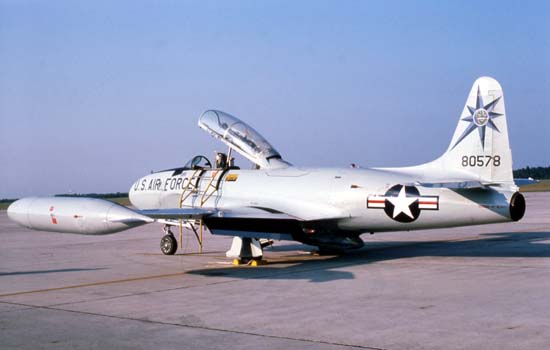 |
|
|
|
In 1976, the largest
birthday party in the nation's history, the Bicentennial (200th)
anniversary of the U.S. independence, was underway. To celebrate the
Bicentennial, most squadrons wore the official Bicentennial "Pretzel"
logo (worn on the nose of the F-106's). The U.S. Air Force also gave
each squadron the ability to paint one aircraft in a special paint
scheme, the for the 318th F-106A 58-0776 was selected as their official
Bicentennial aircraft. Painted in its special markings, the aptly named
"Freedom Bird" was dedicated during the squadrons 1975 Hughes Trophy
presentation ceremony on January 24, 1976.
|
|
|
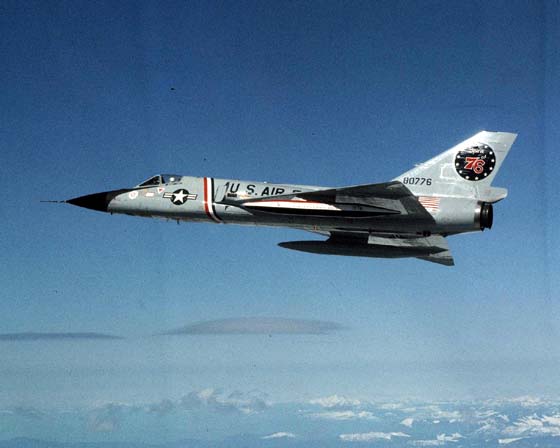 |
|
PHOTO BY GENE JOHNSON |
|
In 1976 the "318
rolled out "The Freedom
Bird" (s/n F-106A 58-0776) to celebrate the 200th anniversary of
the adoption of the Declaration of Independence.
|
|
|
|
In October 1, 1979, the
remaining six Fighter-Interceptor Squadrons were transferred from the
Aerospace Defense Command (ADCOM) to the Tactical Air Command (TAC).
This change in commands prompted one noticeable change, all FIS's would
replace the ADCOM & unit insignias on their tails with the TAC shield,
unit insignias would eventually move to the nose of the F-106's.
|
|
|
|
In the early 80's fuel
tank markings would reappear on 318th F-106's & T-33's. Using the same
shades of blue as the "Starburst" maintenance crews painted a white
bordered chevron or "swoosh" on both sides of the of the interchangeable
tanks of the F-106. The wing tanks, chaff pods and luggage pods used on
the units T-33s would receive also the 318th swoosh.
|
|
|
|
As F-106 operations
wound down for the upcoming transition to the F-15 Eagle, all unit
specific markings were removed the F-106's in preparation for their new
assignment to their next units.
|
|
|
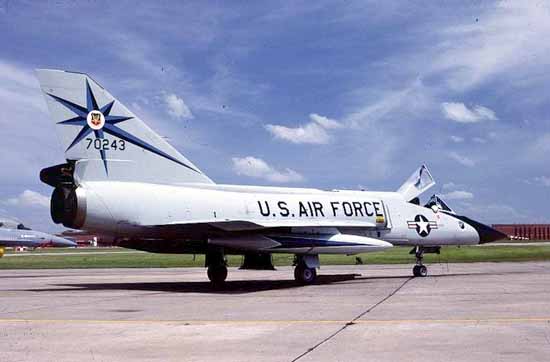 |
|
|
|
The full "Starburst"
markings are displayed by F-106 s/n 57-0243 & T-33 s/n 58-2106, note the
Tactical Air Command decal replacing the ADCOM and unit insignia.
|
|
|
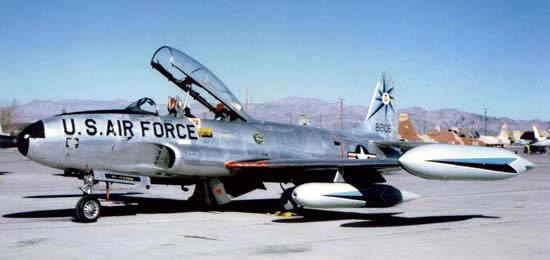 |
|
|
|
Now the trademark for
the squadron, the "Starburst" found a new home on the Green Dragons F-15
Eagles. In preparation for the arrival of the F-15's 318th crews painted
the reworked tail, flash on the first Eagle, F-15B 76-0141, at Luke AFB
before the aircraft's flight to its new home at McChord. An eagle
placard, dark blue (F.S. 15044) eagle head with a light blue (F.S.
15200) crew panel would be
added to round out the new design.
|
|
|
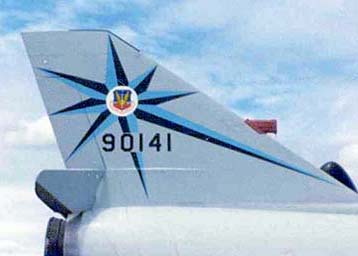 |
|
x x |
|
The 318th
"Starburst" of the F-106 (as seen on the units last F-106, s/n 59-0141)
is compared with the first F-15B 76-0141,
the 318ths first F-15 had a design unique the the aircraft, using a the
standard s/n position, painters broke through the lower leg of the
"starburst" design. The more common F-15 "Starburst" arrangement can be
seen on the right (F-15A 76-0057).
|
|
|
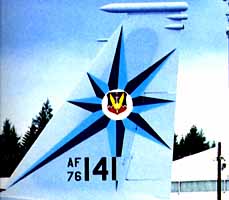 |
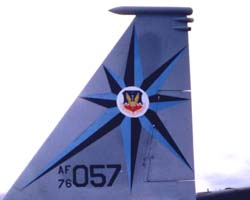 |
|
|
|
The F-15s "Starburst" required a
reduction in size and a relocation of the F-15s serials, except for the
markings found on F-15B -141 upon its arrival at McChord. A standard
F-15 serial number was used, because of this, the lower leg broke
through the serial number, but it was later painted to match the other
aircraft. The 318ths MXU-648 Travel
pods wore a swoosh similar to the wing tanks of the F-106s & T-33s
although they lacked the white outline.
|
|
|
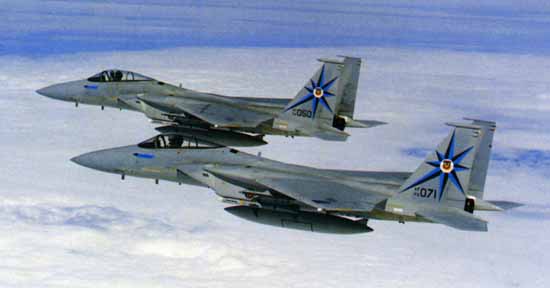 |
|
x |
|
F-15As s/n 76-0050 &
s/n 76-0071 in full 318th FIS "Starburst" markings carry live AIM-7
Sparrow missiles high above the clouds in Washington State.
|
|
|
|
The last major marking
change occurred in 1987 with an order from higher headquarters of
Tactical Air Command to align all of the commands aircraft to a uniform
standard, two letter unit designators. This order only affected only
the two remaining air defense F-15 units.
|
|
|
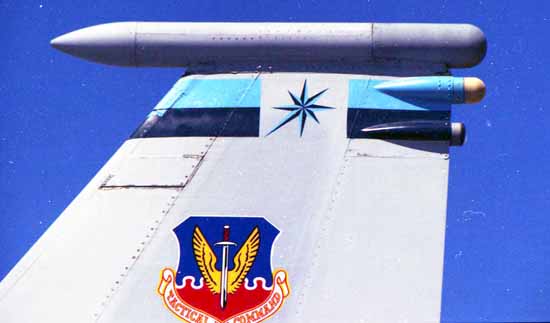 |
|
x |
|
After the order to
remove their tail flashes from their F-15's, the "Starburst" lived on as
a main component of the units tail stripe.
|
|
|
|
In that year, the 318th
FIS began to repaint the tails of their F-15's with the tail code "TC",
(derived from McChord's International Air Transport Association airport
code of "TCM" which stood for Tacoma), the major city near the base. The
trademark "Starburst" remained in a much smaller form, contained in the
center of a dark & light blue tail band on the top of the F-15's
vertical stabilizers at least one aircraft (F-15B 76-0139) carried a
318th swoosh on the top of its tail. Initially the units F-15 kept their
full color eagle head crew placards, later the colors were changed to
black (head) and dark gray (crew panel).
|
|
|
|
In 1988, the 318th was
deep in the planning stages for a upcoming conversion to the Air Defense
variant of the F-16 Fighting Falcon. On January 9, 1989, the Department
of Defense announced that the 318th FIS would inactivate by the end of
1989, canceling the squadrons conversion into the F-16 ADF. Since no
F-16's had been assigned to the squadron, it is thought
that markings for the tails of 318th FIS F-16 were not officially
designed for the aircraft.
|
|
|
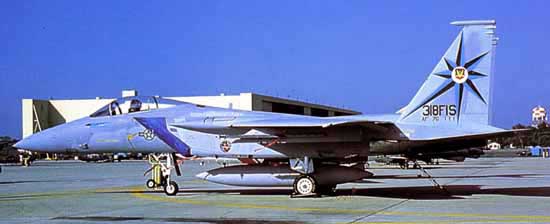 |
|
|
|
F-15 before and
after - The squadrons last flagship, F-15A 76-0111 displays the classic
air defense "tail flash" and the later tactical marking design.
|
|
|
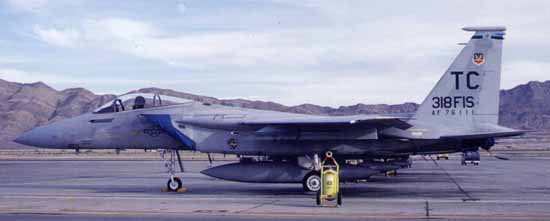 |
|
|